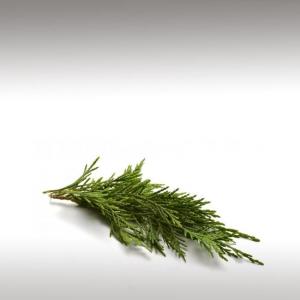
CYPRESS ESSENTIAL OIL (CUPRESSUS SEMPERVIRENS) - ESSENTIAL OILS

BASE / GENERAL DATA
Information submited: May 29, 2015 Modified: March 7, 2018 By: OperaDreamhouse
Botanical Name: Cupressus sempervirens
Common Method of Extraction: Steam distillation
Part Typically Used: Needles and twigs
Color: Pale Yellow
Consistency: Thin
Perfumery Note: Top / Middle
Strength of Initial Aroma: Fresh, herbaceous, slightly woody, evergreen aroma.
Cupressus Sempervirens, the Mediterranean Cypress (also known as Italian Cypress,Tuscan Cypress, Graveyard Cypress, or Pencil Pine) is a species of Cypress native to the eastern Mediterranean region, in northeast Libya, southern Albania, southern coastal Croatia, southeast Greece, southern Turkey, Cyprus, northern Egypt, western Syria, Lebanon, Israel, Malta, Italy, western Jordan, and also a disjunct population in Iran.
Cupressus Sempervirens is a medium - sized coniferous evergreen tree to 35 m tall, with a conic crown with level branches and variably loosely hanging branchlets. It is very long - lived, with some trees reported to be over 1,000 years old.
The foliage grows in dense sprays, dark green in colour. The leaves are scale - like, 2-5 mm long, and produced on rounded (not flattened) shoots. The seed cones are oval or oblong, 25-40 mm long, with 10-14 scales, green at first, maturing brown about 20-24 months after pollination.
The essential oil of Cypress is obtained through steam distillation of young twigs, stems and needles. Cypress, a needle bearing tree of Coniferous and Deciduous regions, bears the scientific name of Cupressus Sempervirens.
Has been used for thousands of years as a cleansing incense for several Nepalese and Tibetan cultures. Cypress trees were planted outside of temples and burial grounds by the Greeks and Romans.
Chemical strucutre:
The essential oils extracted from Cypress contain components like alpha pinene, beta pinene, alpha terpinene, bornyl acetate, carene, camphene, cedrol, cadinene, sabinene, myrcene, terpinolene and linalool, which contribute to its medicinal properties.
Common Method of Extraction: Steam distillation
Part Typically Used: Needles and twigs
Color: Pale Yellow
Consistency: Thin
Perfumery Note: Top / Middle
Strength of Initial Aroma: Fresh, herbaceous, slightly woody, evergreen aroma.
Cupressus Sempervirens, the Mediterranean Cypress (also known as Italian Cypress,Tuscan Cypress, Graveyard Cypress, or Pencil Pine) is a species of Cypress native to the eastern Mediterranean region, in northeast Libya, southern Albania, southern coastal Croatia, southeast Greece, southern Turkey, Cyprus, northern Egypt, western Syria, Lebanon, Israel, Malta, Italy, western Jordan, and also a disjunct population in Iran.
Cupressus Sempervirens is a medium - sized coniferous evergreen tree to 35 m tall, with a conic crown with level branches and variably loosely hanging branchlets. It is very long - lived, with some trees reported to be over 1,000 years old.
The foliage grows in dense sprays, dark green in colour. The leaves are scale - like, 2-5 mm long, and produced on rounded (not flattened) shoots. The seed cones are oval or oblong, 25-40 mm long, with 10-14 scales, green at first, maturing brown about 20-24 months after pollination.
The essential oil of Cypress is obtained through steam distillation of young twigs, stems and needles. Cypress, a needle bearing tree of Coniferous and Deciduous regions, bears the scientific name of Cupressus Sempervirens.
Has been used for thousands of years as a cleansing incense for several Nepalese and Tibetan cultures. Cypress trees were planted outside of temples and burial grounds by the Greeks and Romans.
Chemical strucutre:
The essential oils extracted from Cypress contain components like alpha pinene, beta pinene, alpha terpinene, bornyl acetate, carene, camphene, cedrol, cadinene, sabinene, myrcene, terpinolene and linalool, which contribute to its medicinal properties.

SPIRITUAL PRACTISES DATA

MEDICINE / HEALTH DATA

BEAUTY / COSMETICS DATA

FOOD / COOKING DATA
COMMENTS
No comments.


